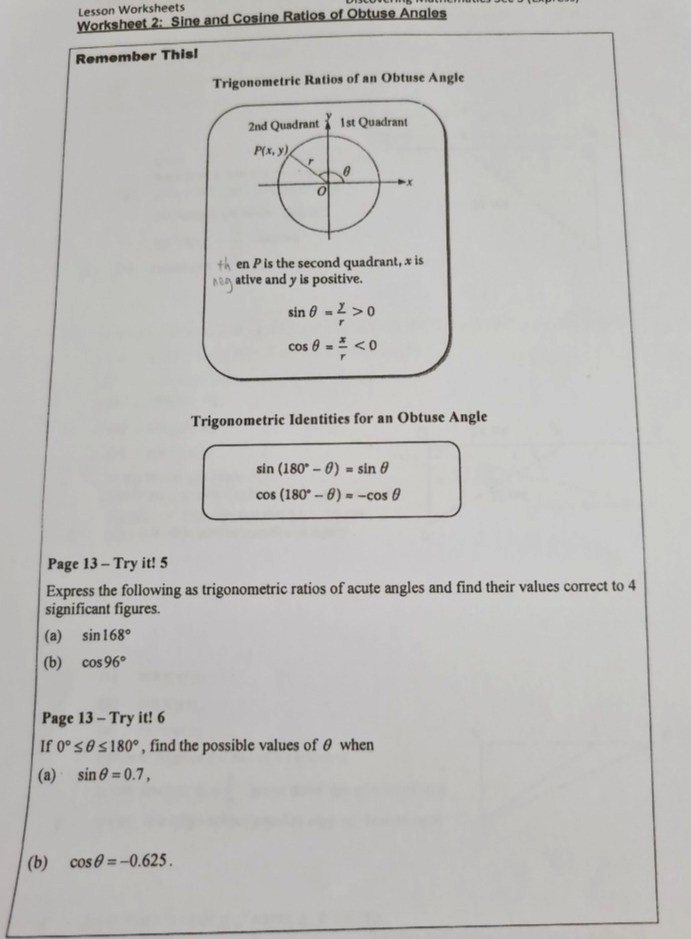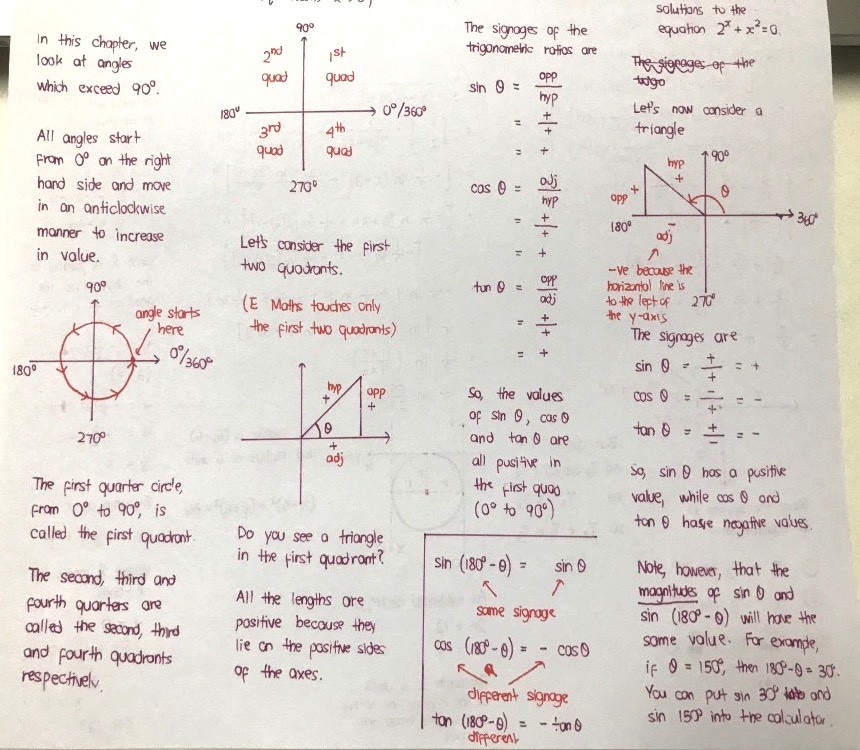Ask Singapore Homework?
Upload a photo of a Singapore homework and someone will email you the solution for free.

Question
secondary 3 | A Maths
One Answer Below
Anyone can contribute an answer, even non-tutors.

can someone explain what does this mean, im kinda confused about the whole circle thing
In Sec 2 you only learn for angles up to 90.
The upper left quadrant is called the “second” quadrant, reserved for an angle 90 to 180.
Now, we draw a horizontal line from the origin. Suppose a line points rightwards to the x-axis. We say that the line is at an angle 0 degrees with respect to the quadrants diagram. If the line points northwards, the line is at an angle 90 degrees. If a line points north-east, it could be at an angle 38 or 75, for example.
Similarly, a line which points towards the north-west can be 110 or 167, for example. A line going to the west indicates an angle of 180.
An angle of 30 degrees, for example, is a line originally at 0 degrees which has been rotated 30 degrees anticlockwise about the origin as the pivot. This angle is said to be 30 degrees.
An angle of 150 degrees, for example, is a line originally at 0 degrees which has been rotated 150 degrees anticlockwise about the origin as the pivot. However, we can also say that it starts at 180 degrees and rotated 30 degrees clockwise about the pivot.
I will teach you on the basic angle next time if I am still in this forum.
(Full treatment is seen in A Maths, including quadrants, so I will skip the quadrants for now)
Two angles are said to be supplementary when they add up to 180.
For example, 23 and 157 are supplementary angles, because they add up to 180 degrees.
I would like you to calculate the trigonometric ratios of some pairs of angles.
Let's consider 30 and 150,
I would like you to calculate sin 30 and sin 150 and comment on these two values.
Similarly, do likewise for cos 30 and cos 150. Pay attention to the signages and the digits.
Do likewise for tan 30 and tan 150. What are you able to tell me about the digits and the signages?
a. 5, 175
b. 24, 156
c. 39, 141
d. 87, 93
Like in (a), for example, I would like you to inspect sin 5 versus sin 175. Inspect cos 5 versus cos 175. Inspect tan 5 versus tan 175. What do you notice?
Repeat the above for the other angles.
Howsoever, you do the above, you will realise that for sin, the sines of both angles will have the same signages and the same digits.
So, if x and 180 - x are supplementary angles, then we can say that
sin (180 - x) = sin x
This is called the supplementary angle rule for sine.
If you have done the work for cos, you will notice that the cosines of both angles will have opposite signages but the same digits. So, we have the relation
cos (180 - x) = - cos x
Likewise for tan, you will notice that the tangents of both angles will have opposite signages but the same digits, leaving us with the relation
tan (180 - x) = - tan x.
These three make up what you will be learning in E Maths.
Full treatment of this is done in A Maths, and it's probably not the right time for me to explain.
cos 30 is 0.866 while cos 150 is -0.866 (same value but one is negative, ons is positive)
tan 30 is 0.577 while tan 150 is - 0.577 (same value but different signs)
cos ACD
= cos (180 - ACB) because ACB + ACD is 180
= - cos ACB (supplementary angle rule)
= - 7/8
sin 168
= sin (180 - 12)
= sin 12 using the formula
= calculator value
cos 96
= cos (180 - 84)
= - cos 84 using the formula
= calculator value
sin x = 0.7
Remember that the sine of an angle in the first quadrant (0 to 90) is positive, while the sine of an angle in the second quadrant (90 to 180) is positive also.
So, if sin x = 0.7 (0.7 is a positive value), the angle x can be 0 to 90 or 90 to 180.
x can be
sin-1 (0.7) or 180 - sin-1 (0.7).
We put this in the calculator. First possible value is sin-1 (0.7). Second possible value is 180 - our first answer as you saw when you typed sin 30 and sin 150. Both yield 1/2, so if sin x = 1/2, then x can be 30 or 180 - 30.
cos x = -0.625
Remember that the cosine of an angle in the first quadrant (0 to 90) is positive, while the cosine of an angle in the second quadrant (90 to 180) is negative. These have opposite signs.
So if cos x = -0.625 (a negative value), angle x must be between 90 and 180.
We write this as
x = 180 - cos-1 (0.625)
(we still put 0.625 instead of -0.625 in the brackets, since the “180 - angle” has already taken into account that our answer is an obtuse angle between 90 and 180).
See 1 Answer




